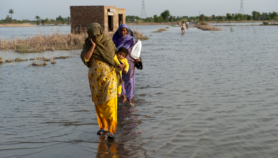By: Neena Bhandari
Send to a friend
The details you provide on this page will not be used to send unsolicited email, and will not be sold to a 3rd party. See privacy policy.
[SYDNEY] Asia accounts for more than half of the over five million global deaths attributed to ambient cold and hot temperatures, according to an international study. But many governments are failing to prioritise health in their climate change strategies, experts warn.
The study, published 1 July in The Lancet Planetary Health, found that mortality rates in low-lying and crowded coastal cities in East and South Asia were particularly affected by temperature.
Researchers found that 9.4 per cent of global deaths from 2000 to 2019 could be attributed to non-optimal temperatures, with most of those caused by exposure to cold. However, this is predicted to change as global warming increases heat-related deaths.
“Over 2.4 million people died annually due to cold in Asia, followed by 1.18 million cold-related deaths in Africa. But our findings show that in the long-term global warming is expected to increase the heat-related mortality burden,” says study author Yuming Guo, a professor from Monash University’s School of Public Health and Preventive Medicine in Australia.
The findings come as the Global Climate and Health Alliance warns that governments are not doing enough to prioritise health in their national climate commitments ahead of COP26, the UN climate change summit, later this year. This is despite extreme temperatures, resulting in heatwaves, forest fires and cold snaps, having severe impacts on health.
The Global Burden of Diseases, Injuries, and Risk Factors Study 2019 showed that non-optimal temperatures were among the 10 leading causes of death worldwide.
“Understanding the geographic patterns of temperature-related mortality is important for future climate change and health-related policies and strategies”
Yuming Guo, Monash University’s School of Public Health and Preventive Medicine
“Understanding the geographic patterns of temperature-related mortality is important for future climate change and health-related policies and strategies,” says Guo. “During the 20-year period (2000-2019), earth’s temperature increased by 0.26 degree Centigrade per decade. This reduced cold-related deaths by 0.51 per cent and increased heat-related mortality by 0.21 per cent, which led to a reduction in net mortality due to hot and cold temperatures.”
The study also calculated the global annual excess death ratio and excess death rate to evaluate the geographical variation in temperature-related mortality burden.
Of all excess deaths, about 51 per cent occurred in Asia, 24 per cent in Africa, 16 per cent in Europe, eight per cent in the Americas, and 0.5 per cent in Oceania.
Fiona Armstrong, executive director of the Climate and Health Alliance says: “This study confirms that we can expect more deaths worldwide from heat exposure driven by climate change, which poses a threat to people’s health in the short and long term.
“Nations must urgently prepare their health systems to cope, not only with the increased illness and deaths from heat, but with all climate-related health impacts — extreme weather, novel infections and vector-borne diseases, mental distress, food and water insecurity, and more.
“Wealthy countries, like Australia, must bear their fair share of the global responsibility for reducing emissions and supporting lower-income countries to make the transition, accounting for historic emissions and health equity.”
This piece was produced by SciDev.Net’s Asia & Pacific desk.















